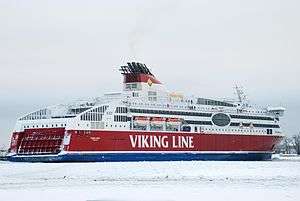Ice class

Ships with an Ice Class have a strengthened hull to enable them to navigate through sea ice.
History
The first requirements for merchant ships to be escorted by icebreakers were set in Finland in 1890, after winter traffic to the port of Hanko was started. In the past, different classification organizations had different standards, rules, and ice classes. Converting between the Baltic and Arctic systems is not usually done. Recently, the two different class systems have been defined by the International Association of Classification Societies (IACS) and the International Maritime Organization (IMO).
Significance of ice class
Not all ships are built to an ice class. Building a ship to an ice class means that the hull must be thicker, and more scantlings (aggregate of girders, beams, and bulkheads resulting in stronger structural integrity) must be in place. Sea chests (openings in the hull for seawater intake) may need to be arranged differently depending on the class. Sea bays may also be required to ensure that the sea chest does not become blocked with ice. Most of the stronger classes require several forms of rudder and propeller protection. Two rudder pintles are usually required, and strengthened propeller tips are often required in the stronger ice classes. More watertight bulkheads, in addition to those required by a ship's normal class, are usually required. In addition, heating arrangements for fuel tanks, ballast tanks, and other tanks vital to the ship's operation may also be required depending on the class.
Arctic classes
The American Bureau of Shipping has a system of ice classes which includes classes A5 through A0; B0, C0, and D0. A5 class is the strongest built of the classes, with D0 being the weakest. All other major classification societies have a similar system of ice classes, and converting between ice classes is relatively easy. In most cases only the names of the classes are changed and the specifics of the Arctic class are identical. ABS Class A5 is the only Arctic Class that may act independently in extreme Arctic waters with no limitations. Other classes are subject to limitations on time of year, required escort (always with a vessel of higher ice class) and ice conditions.
The ABS database includes hundreds of Arctic Ice Classed ships, including many Arctic Research Vessels,[1] and the entire productions of certain shipyards.
Finnish-Swedish ice class
In the Finnish-Swedish ice class rules, merchant ships operating in first-year ice in the Baltic Sea are divided into six ice classes based on requirements for hull structural design, engine output and performance in ice according to the regulations issued by the Swedish Maritime Administration and the Finnish Transport Safety Agency (TraFi). International classification societies have incorporated the Finnish-Swedish ice class rules to their own rulebooks and offer equivalent ice class notations that are recognized by the Finnish and Swedish authorities.[2]
Ships of the highest ice class, 1A Super, are designed to operate in difficult ice conditions mainly without icebreaker assistance while ships of lower ice classes 1A, 1B and 1C are assumed to rely on icebreaker assistance. In addition there are ice class 2 for steel-hulled ships with no ice strengthening that are capable of operating independently in very light ice conditions and class 3 for vessels that do not belong to any other class such as barges.[3] The classes can also be spelled with Roman numerals.
Traffic restrictions in the Baltic Sea during winter months are based on the Finnish-Swedish ice class. These restrictions, imposed by the local maritime administrations, declare the minimum requirements for ships that are given icebreaker assistance, for example "ice class 1A, 2000 DWT".[4]
IACS Polar Classes
The International Association of Classification Societies published a set of Unified Requirements for Polar Class Ships[5] to complement the IMO Guidelines for Ships Operating in Arctic Ice Covered Waters. This will effectively unify the ice classes for all IACS member societies. Seven Polar Classes are proposed in the requirements, abbreviated as PC1 through PC7[6]
References
- ↑ Research Vessels, Ice Classed
- ↑ The Ice Class Regulations 2010 and regulations about the list of equivalences and the documentation required for the determination of the ice classes of ships to enter into force on 1 Dec. 2010. Finnish Transport Safety Agency (TraFi), 25 October 2011. Retrieved 2011-11-21.
- ↑ Ice class regulations 2008 (Finnish-Swedish ice class rules). Finnish Maritime Administration Bulletin 10/10.12.2008. Retrieved 2011-10-31.
- ↑ Aro, Ilmari: Icebreaking management on Finnish coast. Finnish Maritime Administration. Retrieved 2010-06-22.
- ↑ http://www.iacs.org.uk/document/public/Publications/Unified_requirements/PDF/UR_I_pdf410.pdf
- ↑ Low Temperature Operations - Polar Class Guidance (ABS Newsletter).
- GENERAL SPECIFICATIONS FOR MARINE AND AERIAL SUPPORT VESSELS (several Arctic/Polar classed vessels)
- ABS Rules for Steel Vessels 2007, Part 6- Optional Items and Systems
- Eyres, David J. Ship Construction. 1st ed. Elsevier, 2007. 36-39.